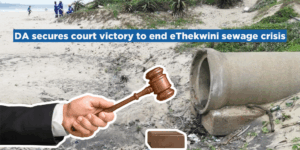Recently a delegation led by Deputy Minister of Water and Sanitation, Pam Tswhete, paid a visit to the Preekstoel Water Purification Plant in Hermanus. Hosted by the Overstrand Municipality, the visit was in keeping with the Department’s study of various water and sanitation projects that could offer countenance to the drought and subsequent dwindling water shortages experienced in a number of public water supply schemes or dams across the Country. A situation made worse by pro-longed lower-than normal rainfall in the months preceding.
Mitigating measures considered by the Department to ensure the Country’s water resources become more viable, include the strict implementation of drought operating rules at all dams; increasing the water mix especially groundwater utilisation, rain harvesting, re-use of return flows and packaged desalination plants; reducing operational risks by proper infrastructure operation and maintenance with associated skills development; implementation of water conservation and demand management programmes and climate research, as well as hydrological and geo-hydrological monitoring.
Commencing on 30 September 2011, the R85.1 million Preekstoel project was made possible through funding between the Overstrand Municipality (R57.6 million), the Department of Water and Sanitation (R20.6 million) and the Department of Cooperative Governance and Traditional Affairs (CoGTA) (R6.9 million).
Added to that, Aurecon were engaged as consulting engineers, and Inyanga Projects and PCI Africa as civil and mechanical and electrical contractors respectively. Umvoto Africa (Pty) Ltd was further contracted as consultants to support the municipality in the development of its well-fields in the region.

The need for the plant was born mostly by urban growth, a swell of new business and an increasing rise of households in the area. Further upgrades were hence done to accommodate future development that could be restrained by threatened water supply, especially when rainfall is below average.
As a first of its kind in South Africa, the specific purpose of this plant is to remove the very high iron and manganese content from the borehole water, before being blended with the treated surface water from the De Bos Dam, through a unique bio-filtration system used to remove high manganese and iron content found in ground water. This entails creating ideal conditions for specific iron and manganese bacteria to grow in the filter media.
In the process of purification, the bacteria in turn consume the iron and manganese in the water. The potential of hydrogen (pH) and the dissolved oxygen content are controlled to create the right conditions for the bacteria.
Speaking from the site, the Deputy Minister said, “We’ve been working closely with the Overberg District Municipality, including the Overstrand, Swellendam, Grabouw and Struisbaai, to ensure continued supply of water through the construction and maintenance of waste water treatment works such as this in the region.”
“I have to thank the Overstrand Municipality, its management and operational staff, as too the contractors who collectively have demonstrated the best skills-set ever seen. I salute them for the smooth and seamless transfer of skills, whilst keeping costs to a minimum. The Overstrand is setting the bar for other local municipalities. It would be in our best interests to learn from this experience and share our findings and information gathered with the rest of the country,” she enthused. The Deputy Minister also made a point of thanking the media in attendance for their continued support of the work of the Department.
In closing, she urged the community to protect the facility to ensure it remains functional and laid an appeal to use water sparingly, not waste water and to report water leaks found at homes, schools and other municipal and government facilities.




